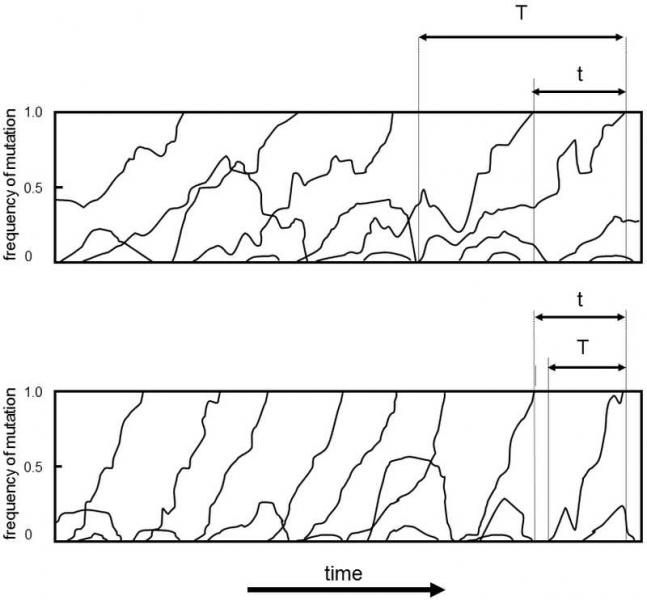V.3.3 The frequency of fixation of neutral mutations in time does not depend on the size of the population.
The rate of fixation of mutations in the population through genetic drift, i.e. the number of mutations that are fixed through drift per time unit, is given both by the number of all mutations formed in the population per time unit and also by the probability with which newly formed mutations will become fixed in the population.In the equilibrium state, the frequency of fixation of mutations by drift does not depend on the time required on an average by a mutation to achieve fixation (Fig. V.9).The

Fig. V.9. Trajectory of fixation of mutations in large and small populations. The average time required for fixation of selectively neutral mutations by genetic drift (T) in a large population (a) is substantially longer than in a small population (b). Nonetheless, the substitution rate or its reciprocal value (t) – the average length of the interval separating two subsequent fixation events – does not depend on the size of the population and is always equal to the mutation rate for neutral mutations
probability of fixation of a new neutral mutation (u) in a population of diploid organisms with size N is equal to 1/2N.The number of mutations being formed is given by the sum 2Nv, where v denotes the number of mutations formed per gamete per generation period and N is the size of the population (in haploid organisms, the number of newly formed mutations is equal to Nv).The number of alleles fixed in the population per time unit (k), i.e. the substitution rate, is equal to a multiple of the number of newly formed mutations and the probability of fixation of mutated alleles:
k = 2Nvu. (4)
Substitution of u = 1/2N yields the equation
k = v. (5)
This means that the fixation of selectionally neutral traits by genetic drift occurs with a frequency that equals the frequency of mutations in one gamete per generation.This value is thus completely independent of the size of the population in which fixation occurs.In other words, in a large population, the probability of fixation of newly formed mutations is smaller than in a small population; however, on the other hand, a greater number of mutations are formed over the same period of time.
